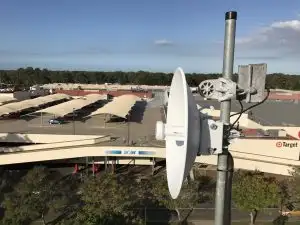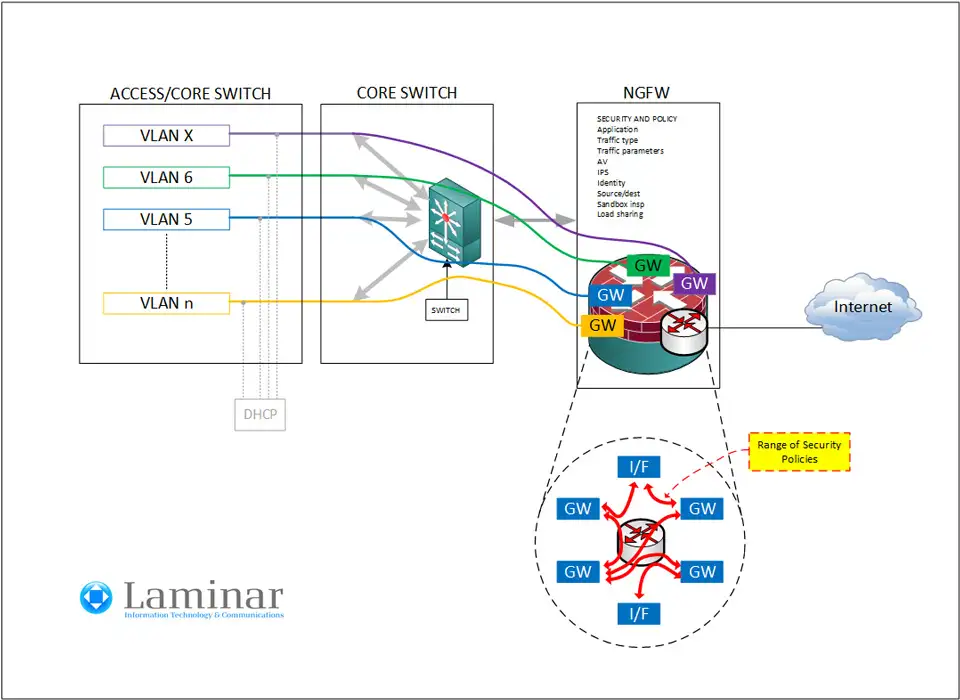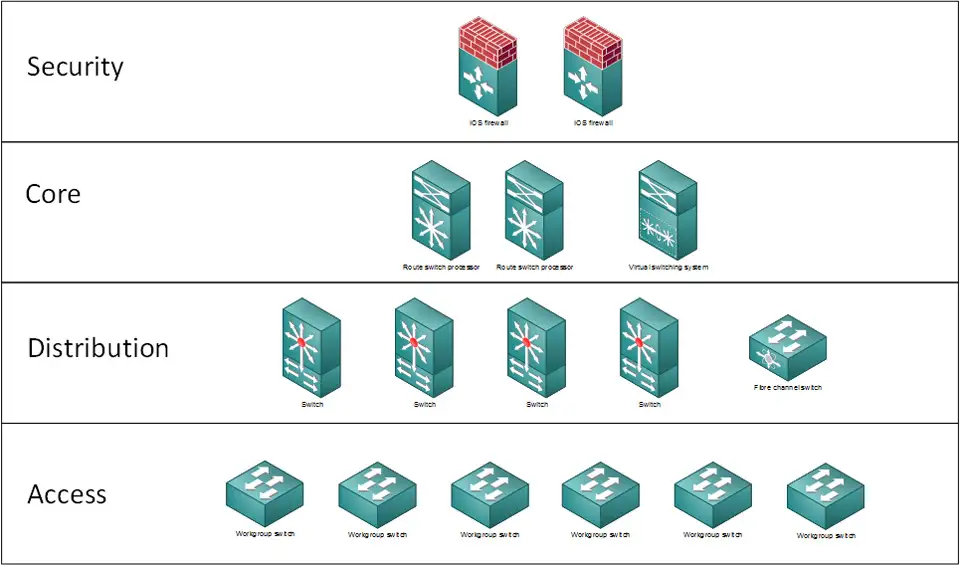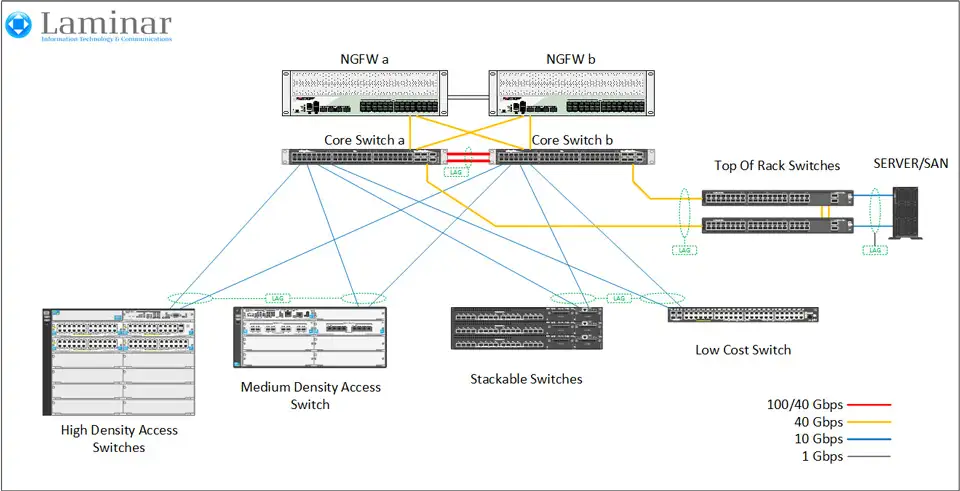Winds of Disruptive Change in Networking
I am noticing a change in the network industry, that is likely again to be very disruptive. It might seem a strange thing to say, because our industry is constantly changing at a rapid rate. However it’s a change that could send the industry in a new direction or perhaps will challenge the status quo. These areas are wireless communications and flat SDN based networks.
We (Laminar) do a lot of work in the wireless field and in the last year our vendors have released new products that are likely to disrupt some of the established players within sectors of our industry. The wireless technology development I would like to discuss is the short haul link and wifi technology. The key disruptions are to cost, size and connectivity.
Wireless WAN Links
We have been installing new low cost ($190.00) per end wireless link technology that can easily connect to numerous sites 1-4km away. We are attaining link speeds of 600Mbps in the free wifi spectrum! To provide a comparison, imagine the NBN on the best day with a fibre connection, this wireless technology is 6 times faster and I don’t have to dig up the street!

 Some of this technology is suited for medium distance (1-4km) and looks like a small microwave dish like in the picture above. While this form factor has been available for a while the new 802.11AC based technology is providing a huge jump in performance. These technologies also implement old school methods such as launching two streams from the same antenna with a polarity shift of 90 degrees.
Some of this technology is suited for medium distance (1-4km) and looks like a small microwave dish like in the picture above. While this form factor has been available for a while the new 802.11AC based technology is providing a huge jump in performance. These technologies also implement old school methods such as launching two streams from the same antenna with a polarity shift of 90 degrees.
The company who have released this technology, Ubiquity, have also released some very small systems the size of a tea saucer that can attain 600Mbps across the street or park. Ideal for delivering internet, payTV and other internet services (at $90.00 per end). They also have higher end products that cost several thousand dollars, which provides multi Gbps over 4 Km or so and sub 1Gbps at 30-60Km. We can also see applications here for remote high definition security camera deployment.
Smaller WiFi Cells
The speed of some of the new wireless Wi-Fi access points (APs) we are installing are capable of connection rates of 3.8Gbps. Most laptops and tablets are not equipped with this capability yet but we are expecting an update at Christmas when the latest technology is released! The key development is that the applications using these speeds are advancing quickly.
I predict that organisations will implement many small high speed wireless cells that not only connect traditional phones, tablets, laptops and so on to the internet or enterprise systems, but also Internet Of Things (IOT) devices, keyboards, screens, projectors, security scanners, lighting and a plethora of other devices.
However my prediction is a little belated, as we are already implementing small cell based WiFi systems using current 802.11AC technology for some corporate and government customers. These are typically an AP per room and still provide traditional connectivity to the corporate systems and the internet. They are very similar to what we install in hotel rooms, but the cost has dropped and the functionality is suitable for corporate implementations.

 Essentially it means wireless cells will get smaller. Today a wireless WiFi cell will cover a classroom, 3 -10 offices, part of a floor or roughly 150-250m2. In the near future this cell size will cover the desk, office or work area. Standards have already been developed (IEEE – 802.11AX/AD etc) for this capability several years ago and I have heard mainstream chip vendors are marketing the appropriate silicon (specialised integrated circuit chips) which means engineers will be/are developing prototypes.
Essentially it means wireless cells will get smaller. Today a wireless WiFi cell will cover a classroom, 3 -10 offices, part of a floor or roughly 150-250m2. In the near future this cell size will cover the desk, office or work area. Standards have already been developed (IEEE – 802.11AX/AD etc) for this capability several years ago and I have heard mainstream chip vendors are marketing the appropriate silicon (specialised integrated circuit chips) which means engineers will be/are developing prototypes.
The 802.11AD technology uses the 60GHz ISM spectrum standard is more advanced as a solution because chipset vendors like Qualcom are shipping silicon, allowing vendors to demonstrate solutions already. The 802.11AD connect speeds support data rates up to 7Gbps and is more spectrally efficient, which means user devices can transmit at high data rates without consuming much power – IE longer battery life, smaller devices etc.
I can see the day in the very near future when a hospital bed will have its own cell which has a plethora of devices communicating between themselves and upstream.

It is highly likely that a cell will cover a desk. Employees will have a virtual work computer operating in their phone that starts up and connects to the screen, keyboard and mouse as they sit down and authenticate themselves.
SDN NETWORKS
Software Defined Networking (SDN) has been around for many years as a concept, technology and set of standards. I have not seen much uptake except in a few bespoke systems, some of which were sponsored by vendors to push the agenda. With many of the networks we implement today, having so much speed I did not see the real need for SDN to control data flows except in the mega data centres such as the heart of Google’s operations.
But I sense this is changing and may be coming from a different direction. Especially with increasing implementations of soft networks (virtual networking) and hybrid physical (traditional IT) and cloud systems.
Many organisations already have some servers operating in their data centers and/or some operating in the cloud. The cloud including virtual servers, infrastructure as a service (IAAS) and software as a service (SAAS). The interesting development is the advent of dynamically scaling infrastructure.
That is, on premise and cloud services that scale up and down as demand requires. The organisation can have a baseline capacity that scales up when there is peak demand allowing them to optimise or minimise costs. That is, they don’t have to build infrastructure to cope with peak loads, rather average the load. I am also seeing more dynamic organisations establish or using services for specific projects and then winding them back frequently using cloud services on a pay per use basis. So it’s not just infrastructure scaling, but services scaling.
With the advent of this dynamic infrastructure, we are seeing the need for traditional IT disciplines to also be established. This includes something close to our heart, security. We are starting to have discussions with customers about dynamic IT security infrastructure that scales up and down with demand.
For example as new servers are spawned in a cloud provider IAAS, the organisations system will automatically implement a security framework before any other virtual infrastructure is established. The idea being that control of information is always in the owner’s hands.
So what does that mean for implementation of today’s networks. We are designing and implementing networks where the traditional core router is replaced by a high performance Next Generation Firewall NGFW and fed by low cost access switches and very high speed.

These NGFW’s can function as a switch/router but more importantly coordinate security policies in physical and virtual infrastructure. It makes the feed, switching and routing simpler which translates to lower cost, higher performance and more control. The start of real SDN! That is, the dynamic control of information flow based on a range of policies.
So why is this disruptive? It means the switching and routing infrastructure is “flatter” and much lower in cost. To explain, the traditional model of building an enterprise network is to create an architecture as depicted in the picture below. This example is at a single site or campus. This multi tiered system has distributed routing and switching.

This new infrastructure permits the network to be flatter with the sophisticated functionality engaged centrally. In the example below there are only three levels and many facets of the network are virtualised. This means a significant part of the functionality of a network can be upgraded with a simple firmware update.
The access switches in this example can be low cost as long as they can switch and feed two 10Gbps interfaces up to the core. With the likes of Broadcom and other vendors offering a switch on a chip type of technology vendors can now offer access switch products at much lower prices. The prices vary by vendor but in some cases the prices can be a quarter or third of traditional competition. Some established vendors even have products in their own product range disrupting their higher end products. So in simple terms customers can implement much faster networks for a significantly lower price.

Summary
Disruption is all around us and while we are generally a part of the disruptive forces in the world, now even our space is being disrupted. I find it fascinating that we are entering a time when the network is automatically scaling with infrastructure and services and has to embody security disciplines as it does so. I know there are many questions to be answered or technical hurdles to engineer, but I have a feeling these will be developed as we jump off the cliff and build the plane on the way down! Makes it exciting don’t you think…
